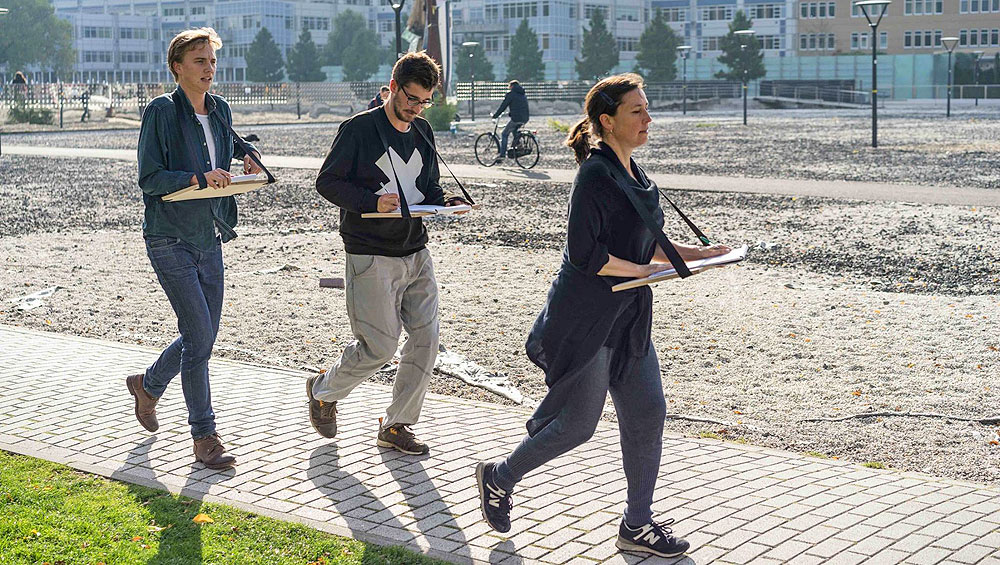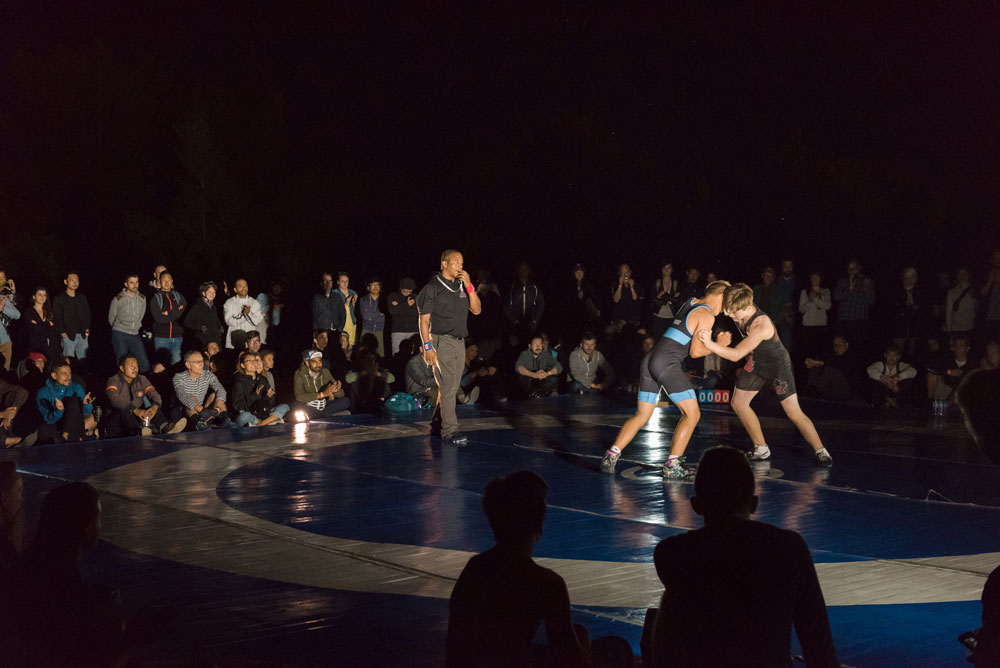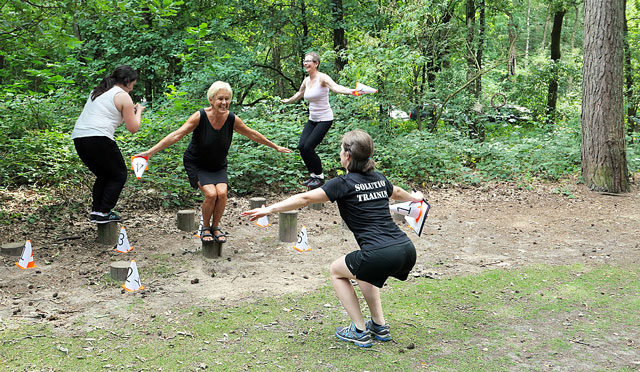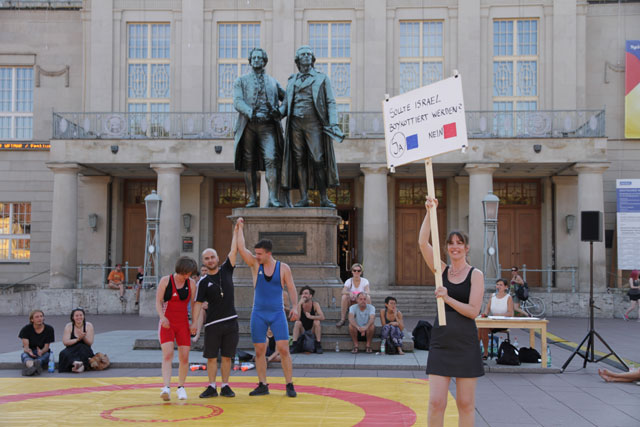
by IZABELLA SCOTT
Vanessa Brazeau (b1986) is a Canadian performance artist, who studied at Bauhaus-Universität Weimar and lives in Germany. Using fitness, sports and athletics as a framework of critique, she devises absurd exercise routines and high-stakes wrestling matches, thinking up fitness apps and postmodern gyms. By hijacking the language of productivity and competition, her performances – which take the form of marketing interventions, promo videos and fitness classes – critique neo-liberal mentalities of the body and encourage resistance, participation and sweat.

Vanessa Brazeau. The Solution Mat. Image: Priam Thomas for Art Spin, Toronto, CA, 2017.
I met Brazeau in Slovenia during Fotopub, an international festival of performance and photography that takes place each August. Brazeau had just shaved her head in a local barber shop, as part of a group performance titled Skin-fade Disconnected Slick-back, and throughout our interview she touched her newly cropped hair in surprise. Over breakfast in Fotopub’s central hub – a sleepy courtyard in Novo Metso, shaded by tall pine trees – we talked about Fitbits, the stock market index and Greco-Roman wrestling.
Izabella Scott: Whenever I catch a glimpse of you talking to other Fotopub festival participants, I see you leading exercise routines or workouts while you talk. Do you connect the fitness of the mind with fitness of the body?
Vanessa Brazeau: I’m interested in the relationship between moving and learning, and the way in which the body can influence thought processes. Movements can make us reason and argue differently, and disrupt habitual ways of thinking. So often the mind and body are treated as separate entities, and I’m trying to break down these binaries and to explore alternative forms of education using movement, which connects the act of thinking to the act of moving.
Thesis Body, 2016.
A good example of this is my project Thesis Body (2016), which was, quite literally, my master’s thesis. I wanted to document the act of moving and brainstorming at the same time – thinking and jogging, a process I called “ideogging”. There is a classical connection between moving and thinking: in Ancient Greece, in the agora or other public meeting places, philosophers such as Aristotle would walk about the Lyceum in order to think; walking was intrinsic to philosophical thought. As part of my thesis, I created a mobile desk that was attached to my body, and I jogged around Weimar and Berlin as I worked. Jogging rather than walking seemed more fitting to our current moment, in which efficiency and speed are so highly valued. So much labour, academic or otherwise, happens behind closed doors, and the labour of thinking is often invisible. I must have looked completely weird, running around and writing things down on my mobile desk – but multitasking is something we do all the time. I just made it visible by performing it in an absurd way.
IS: Jogging while you work is a reminder of the way, under the pressures of late capitalism, time is squeezed for all it can give. There is a certain mania to hot-desking, running to work, eating breakfast bars on the go. Of course, there is a classical aspect to sports and athletics, but in the neoliberal context it becomes something else – fitness.
VB: Sport is often a group activity underpinned by a sense of collectivity, while fitness is more individualistic. It’s about your body, yourself, and I’m interested in fitness as a framework of neoliberal ideas. As I see it, it’s a perfect symbol of how neoliberalism functions in society right now. In my work, I try to use this framework – the language of fitness, perfection, individualisation – and subvert it. I devise absurd exercise routines or think up kinds of gym centres, using the language and aesthetic of fitness culture.
IS: Prison Body (2015) is a good example of this. It takes the form of a promo video for a new gym in a former prison, which uses the prison architecture for “get fit” – activities such as slamming prison doors, running up and down the stairwells. Your voiceover promotes the project with a familiar optimistic spiel: “No fees! No equipment! Get fit!”
VB: At the time I made this video, JVA Weimar, a juvenile prison in Weimar, had been closed for more than a year. As part of my MFA in public art and new artistic strategies, I was given access to the space for several months and I became interested in prison fitness culture. Men and women who are incarcerated live with two main circumstances that are also essential for success in fitness: time and discipline. Some people use their time in prison to change their bodies – and perhaps building the body is a way to take back some form of control. JVA Weimar was up for sale by the state and, during the time I had access, there was a lot of speculation in the community about its future development. Would it become a hostel? An art gallery? Of course, capitalising on, or profiting from, the prison’s former use is part of the logic of consumer culture. I tried to make a video that reflected this. The intentionally cynical line of thought was: prison is a gym; prisoners look great; so let’s offer this same experience to the public. Get your own prison body! I wanted to challenge what we capitalise on and why, and to question the role of discipline in fitness regimes. There is also the question of how people are classified, disciplined and normalised, in the Foucauldian sense, by social processes that they have little direct control over.
Prison Body, 2015.
IS: Looking at the prison body and seeing only “fitness” is such a gross misreading, and your video is dark and funny precisely because it’s very recognisable within the paradigm of consumer culture. The idea of a prison-gym is slightly outrageous and also, somehow, entirely possible. You could imagine somebody having this exact brainwave.
VB: Many developers would see this idea and say: perfect! Over the years, I’ve had responses to my work that have surprised me. I try to create absurd or ironic situations, like the prison gym, to confront people and ultimately to ask them to question their reality, but, instead, some people say, “Wow, that’s cool!”, and accept it.
To give you an example, I created a work for Onomatopee Projects, which commissioned a set of interventions in public spaces in the centre of Eindhoven for its research project We Are the Market! (2017-18). At the time, I was thinking about the freedom/illusion of choice in consumer culture. Because of the influence of advertisements, trends and the opinions of our peers, decision-making is often accompanied by anxiety, pressure and over-rationalisation. There is an excess of possibility, a facade of choice – in reality, the options we are given are propagated by a system that limits choice to a particular framework.
Market Training, 2017.
In Eindhoven, I created an exercise in public space, performing outside a running store. In shops like this, there’s a range of different trainers – various brands, colours and models – but in the end, they are all running shoes, and they’re probably made in the same factory. I wanted to find a way to transcend the malleable mind altogether, and to find a way to randomise commodity choices by making those choices through the body. So, outside the store, I devised a game based on an old playground jump-rope game called Fortune Teller, which I remember from school, where children swing the rope and chant: “Fortune teller, please tell me/what my husband’s name will be,/A, B, C …” When you trip on the rope, the letter is the answer: a clue to the name of the person you’ll marry. I dressed as a trainer/marketing assistant and used this game to offer shoppers a new way to choose what to buy. In my version, when a customer opted to play the game, I screamed the models of various trainers as they jumped the rope; one man bought a pair of $200 (£150) running shoes with this logic. I thought there would be more confrontation, or that people would think it was a ridiculous approach, but often these people were simply happy that I told them what to buy. Others thought I worked for one of the trainer brands, and that it was a great marketing idea.
IS: So, the work was less subversive than you imagined. Does it entice you to push your projects further, to the point where they can’t be integrated so easily?
VB: In some ways, yes, I want my work to be confrontational. But we’re living in a strange moment. In this post-Trump and post-Brexit era, when things that we never imagined could happen are happening, absurdity is losing its effectiveness. There also seems to be a contemporary disillusion with fact and authority, which has left people searching for meaning, for other sources of knowledge and guidance – in this case, the Fortune Teller game offered some kind of advice from a higher power.
IS: Capitalism offers so much choice, and there’s an assumption that choice is a kind of freedom. But, actually, choice can cause great anguish – and the backlash against postmodernism is to want some kind of guidance, some rules.
VB: I’d call this existential angst. I’m interested in the way that we’ve begun to defer to technology to tell us how to think and behave. When I work with randomness or irrationality – like the jump-rope game – I’m also alluding to these algorithms or AI, to probe the question of free will. At what point are our choices actually choices?
IS: In the context of fitness, there’s the emergence of body-tech – things such as Fitbits – wearable aids that track your movements and flash or beep when you’ve been sitting still too long. It is like having a personal trainer. Increasingly, there is also a link-up between health insurance and body-tech – if you keep fit, the payment plan stays low.
VB: I’m trying to disrupt these lines of thought, and the way choice and incentive become conflated. In another project, Solution Training (2017), I ran fitness classes based on circuit-training exercises, which also answered questions about what the participants should do in their daily routines. Should I go out on Saturday night, or not? I ask the participants to line up to run 50 metres. If they begin running with their right foot, the answer is yes; if they begin with the left foot, no. They aren’t told how these questions are answered until they complete the task. For one woman I worked with, the circuit determined a rule about teeth flossing, and she started shouting at me.

Vanessa Brazeau. Solution Training. Image: Jan-Willem van Rijberk and SEA Foundation, Tilburg, NL, 2017.
IS: You triggered something?
VB: Yes, and that’s the idea – to create situations that become so irrational that individuals can’t help but question my authority. They may become aware of a wider structure of control. But I often wonder – is this where we’ve got to? Do we have to push people, or trigger them, to make them realise they’re not in control? I’ve been criticised by other artists, who have called me a “sporty dictator” – partly in jest. But what I hope I’m doing is posing questions about how neoliberalism creates an illusion of choice, and to show how that relates to our physical bodies.
IS: In The Solution Mat (2015-18), two wrestlers enter the ring, each a representative of public debates with yes/no answers – Brexit, say. You seem to work in the opposite direction, suggesting the physical body has agency, and can inform decisions, rather than being an agent of a wider structure.
VB: I first developed The Solution Mat at the Maxim Gorki Theatre in Berlin in 2015. It was at the time when Angela Merkel had opened Germany’s borders to asylum seekers, and not long after the November 2015 terrorist attacks in Paris. There was a tense and clear political divide forming on a lot of issues in Europe. I was thinking about a new strategy for accommodating multiple publics and experimenting with alternative methods for change, in times when citizens are becoming increasingly dissatisfied with the political systems. I found it interesting to bring some of these questions, like Brexit, down to the decision of two bodies fighting in a ring. Watching two bodies in a public space who are wrestling, fighting – how does this change the narrative of how we make decisions, and then accept them? In The Solution Mat, you see two people grappling, and finally one person is pinned to the ground, and the audience – regardless of their differing opinions – can agree that there is a loser and a winner. In purely physical terms, it’s fair.

Vanessa Brazeau. The Solution Mat. Image: Iva Kirova and Kunstfest Weimar, Weimar, DE, 2016.
IS: Did you take part yourself?
VB: I was a wrestler in high school. The Olympic sport of Greco-Roman wrestling is popular in North America and, as a teenager, I wrestled, eventually going to provincial championships in Ontario, and I continued non-competitively for a short time at university. When I started The Solution Mat, I performed as one of the wrestlers along with a friend and collaborator, Antonije Buric, but it was hard on my body. For the two most recent editions of this project, I’ve worked with the Central Toronto Wrestling Club, and plan to approach clubs in other cities as the project continues.
IS: What drew you to wrestling as a teenager? Is there a certain poetry to it?
VB: There’s a certain purity to it, I think, which is why I found it so interesting to use as an alternative to contemporary democracy. Roland Barthes has a chapter on wrestling in Mythologies (1957), where he describes it as a social spectacle and the purest way of seeing a result. There are two bodies pushing against each other, it’s final and decisive – pure gesture. I loved wrestling from the beginning. I found it amazing to see what you can do with a body and nothing else. The tiniest shift of balance can change whether you are in a position of winning or losing.

Vanessa Brazeau. The Solution Mat. Image: Iva Kirova and Kunstfest Weimar, Weimar, DE, 2016.
I was very competitive and that’s where my interest in fitness and sport began – my personal history of competition and perfectionism. I was “in the zone” – and to damaging effects. Wrestling is also about weight. You have to keep in a weight class, which is a category staged three kilos at a time. I would run with a winter jacket and plastic bags over my body to shed two kilos before a weigh-in – a common practice – just so I could reach my goal weight. Even when I stopped, the mentality remained, and I ended up developing an eating disorder and exercise addiction. Eventually, I found ways to visualise this mania, to put it into my artwork, and to do it with some humour. I want these works to resonate with others – and I believe humour is the best way to make art accessible and engaging. Ultimately, both eating disorders and exercise addictions are about control. They provide a way to talk about wider forms of social control.
IS: You are participating in a group project at Fotopub, alongside Sasha Kurmaz, Brad Downey, Stefan Klein and Hildegard Stein. It’s a performance piece in which all of you have had your heads identically shaved. Was this about relinquishing control, in some form?
VB: Until yesterday morning, I had long hair. The style of cut was decided by a local barber, and I allowed something to happen on a visible part of my body that I only had so much control over. So, yes, it’s about this question of free choice and control. Each of us had differing reasons for this project, but questioning the concept of conformity – particularly in the art world – was something I think we all related to. I am also thinking through questions of how I should look, or social expectations, or what defines the feminine. All of this relates back to the question of taking control of your own body – at what point is that control a kind of empowerment, or free will? And at what point does it fit into a larger structure, beyond you?
IS: The experimental writer Kathy Acker wrote an essay, Against Ordinary Language (1993), in which she described her relationship to bodybuilding. She draws a connection between building muscles, repetition and the production of meaning – or shaping the body and shaping the mind. In your work, too, are you looking for new pathways?
VB: I want to create a new vocabulary – to retranslate the understanding of complicated systems through the body, through movement. Perhaps, for me, it isn’t so much about producing meaning, but rather rearranging it.

Vanessa Brazeau. Flex with DAX. Image: Daphna Westerman for the Forecast Forum at the House of World Cultures, Berlin DE, 2018.
I’m in the middle of developing a new work, called Flex with Dax, which is a fitness app that uses data from the German stock market. It’s an attempt to visualise something that’s intangible – and this is what I mean by a new vocabulary: making the invisible visible by shifting how we understand it. In this case, I take the Dax Index, which is the German stock index, and I feed the data into an algorithm. The stock index is constantly rising and falling, and the app would translate these numbers into a variety of movements, which you are asked to perform. It would be location-generated, so if you were walking past, say, a BMW car, the app would flash and say: “BMW is up 1.3 in Dax, so here is your movement: grab the windscreen wiper, and starting pulling out and in with your left arm.” In a state of mass use, these app gestures and actions could create large-scale changes to how we interact and use these products, creating unpredictable factors and disruptions to the market – until, eventually, the cycle changes direction, and our bodies are what influences the fluctuations, and what potentially destabilises the market. At least – that’s the hope!
Flex with DAX, 2018.
IS: In the promo video for Flex with Dax, you have captured the language of marketing. The pitch is hilarious and also strangely convincing: “Revolutionising our relationship to the stock market! An interesting, constantly changing workout!” Is there a logic to the actions? For example, if the index goes down is there one kind of action, and another if it goes up?
VB: It’s completely random – just a set of sporty tasks that interact, in some way, with Dax company products. I wanted to create an arbitrary perspective on systems such as Dax, which are considered of essential importance, but are nevertheless inaccessible to most people. I’m playing with its accessibility by repurposing its meaning. Indexes such as Dax reflect investor sentiment on the state of the economy, but what about the sentiment of the people – the bodies – who are its resource? The logic isn’t in the particular actions performed, but rather in the greater concept of the project, which is an attempt to make the stock market material, physical – something felt. Our bodies and how they perform are now an economy. The body is the ultimate product and Flex with Dax attempts to visualise this literally, as the body becomes the language of market flux. While the stock market remains elusive in detail, most people do know that it is a way of representing the economy’s performance. I want the app to be a physical translation of these ideas, and like all my work, present them in an everyday language to an everyday person, in everyday life.